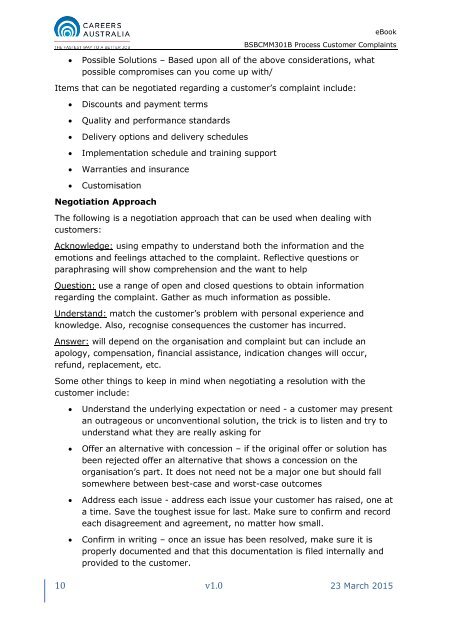BSBCMM301B ebook 23032015
You also want an ePaper? Increase the reach of your titles
YUMPU automatically turns print PDFs into web optimized ePapers that Google loves.
eBook<br />
<strong>BSBCMM301B</strong> Process Customer Complaints<br />
<br />
Possible Solutions – Based upon all of the above considerations, what<br />
possible compromises can you come up with/<br />
Items that can be negotiated regarding a customer’s complaint include:<br />
<br />
<br />
<br />
<br />
<br />
<br />
Discounts and payment terms<br />
Quality and performance standards<br />
Delivery options and delivery schedules<br />
Implementation schedule and training support<br />
Warranties and insurance<br />
Customisation<br />
Negotiation Approach<br />
The following is a negotiation approach that can be used when dealing with<br />
customers:<br />
Acknowledge: using empathy to understand both the information and the<br />
emotions and feelings attached to the complaint. Reflective questions or<br />
paraphrasing will show comprehension and the want to help<br />
Question: use a range of open and closed questions to obtain information<br />
regarding the complaint. Gather as much information as possible.<br />
Understand: match the customer’s problem with personal experience and<br />
knowledge. Also, recognise consequences the customer has incurred.<br />
Answer: will depend on the organisation and complaint but can include an<br />
apology, compensation, financial assistance, indication changes will occur,<br />
refund, replacement, etc.<br />
Some other things to keep in mind when negotiating a resolution with the<br />
customer include:<br />
<br />
<br />
<br />
<br />
Understand the underlying expectation or need - a customer may present<br />
an outrageous or unconventional solution, the trick is to listen and try to<br />
understand what they are really asking for<br />
Offer an alternative with concession – if the original offer or solution has<br />
been rejected offer an alternative that shows a concession on the<br />
organisation’s part. It does not need not be a major one but should fall<br />
somewhere between best-case and worst-case outcomes<br />
Address each issue - address each issue your customer has raised, one at<br />
a time. Save the toughest issue for last. Make sure to confirm and record<br />
each disagreement and agreement, no matter how small.<br />
Confirm in writing – once an issue has been resolved, make sure it is<br />
properly documented and that this documentation is filed internally and<br />
provided to the customer.<br />
10 v1.0 23 March 2015



